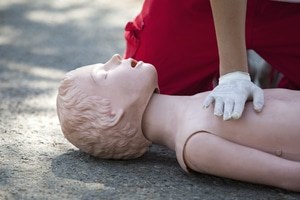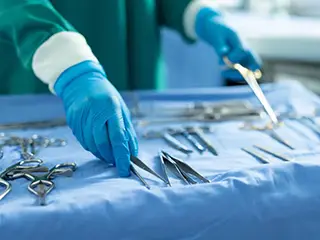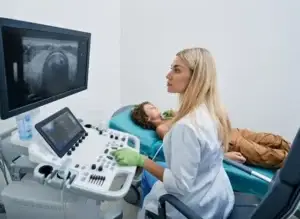 Heaven forbid you ever find yourself in a position where you need to give someone cardiopulmonary resuscitation, commonly referred to as CPR. However, if the situation calls for action, it’s important to be able to help an unresponsive person when their life is on the line. For those interested in learning this lifesaving technique, such as students interested in nursing, it is necessary to take a class and get formally certified. Certifications are good for one year and should be renewed annually, as changes in CPR protocol occur regularly. Regardless of training, it’s good to know the basics of CPR in case there is no one with a certification in your immediate area. That way when someone is potentially not breathing or lacks a pulse you can be of some assistance. When this maneuver is properly executed, it can save someone who has experienced a heart attack or come close to drowning. Here are the common guidelines for performing CPR:
Heaven forbid you ever find yourself in a position where you need to give someone cardiopulmonary resuscitation, commonly referred to as CPR. However, if the situation calls for action, it’s important to be able to help an unresponsive person when their life is on the line. For those interested in learning this lifesaving technique, such as students interested in nursing, it is necessary to take a class and get formally certified. Certifications are good for one year and should be renewed annually, as changes in CPR protocol occur regularly. Regardless of training, it’s good to know the basics of CPR in case there is no one with a certification in your immediate area. That way when someone is potentially not breathing or lacks a pulse you can be of some assistance. When this maneuver is properly executed, it can save someone who has experienced a heart attack or come close to drowning. Here are the common guidelines for performing CPR:
Before performing CPR
First and foremost, remember that CPR is primarily a method of keeping oxygenated blood flowing to vital organs until medical personnel arrive on scene.1 This means that, before anything, you must assess the situation and prepare to call for help. Make sure the environment is safe and that you’re not endangering yourself by helping a person in need. First check to see if the person appears conscious or unconscious. If the person appears unconscious, nudge them and clearly ask if they are okay before beginning CPR.2 Once you have determined that CPR is necessary, send someone to dial 911 if possible. If you are alone, call emergency services and then begin chest compressions. If an automated external defibrillator (AED) is immediately available, administer a single shock before commencing with CPR.3
The basics of CPR
CPR used to be taught by remembering the ABCs, i.e., airway, breathing and circulation. However modern CPR goes by the acronym CAB, in which all the letters stand for the same words, but the order is rearranged to emphasize circulation. The change was implemented to put a new focus on chest compressions, as research has suggested that this is vital to preventing brain and organ damage. This newfound emphasis on circulation occurred after the ABCs had been used for more than 40 years because responders were spending too much time focusing on breathing into the victim’s mouth. This caused a significant delay in responders performing chest compressions.4 Untrained responders should provide hands-only CPR, which means they should only give victims uninterrupted chest compressions at a rate of 100 per minute.5 Only trained responders are encouraged to check the airway and incorporate rescue breathing. Additionally, there are different instructions for performing CPR on adults, children and newborn babies. Adults require firm chest compressions using force from the whole upper body, as each compression should push down the chest at least 2 inches.6 The process for performing CPR on children is very similar, but requires slightly less force. However, administering CPR to an infant requires a different technique. Instead of providing heavy chest compressions with two hands, use two fingers to firmly provide chest compressions 1.5 inches in depth.7
Advancements in CPR
Recently, a device has been designed to help prevent fatigue in first responders who are performing multiple chest compressions. This device has won approval by the FDA, though it is yet to be widely distributed.8 Perhaps the device’s most important feature is that it contains voice commands to instruct users how to give CPR chest compressions to victims. As the majority of people are not up-to-date on CPR protocol, this device helps by giving step-by-step instructions that walk responders through the process. 1“Cardiopulmonary resuscitation (CPR): First aid” by Mayo Clinic Staff. Mayo Clinic. http://www.mayoclinic.org/first-aid/first-aid-cpr/basics/art-20056600 2“Cardiopulmonary resuscitation (CPR): First aid” by Mayo Clinic Staff. Mayo Clinic. http://www.mayoclinic.org/first-aid/first-aid-cpr/basics/art-20056600 3“Cardiopulmonary resuscitation (CPR): First aid” by Mayo Clinic Staff. Mayo Clinic. http://www.mayoclinic.org/first-aid/first-aid-cpr/basics/art-20056600 4“A new order for CPR, spelled C-A-B” American Heart Association Guidelines. October 18, 2010. http://newsroom.heart.org/news/1139 5“A new order for CPR, spelled C-A-B” American Heart Association Guidelines. October 18, 2010. http://newsroom.heart.org/news/1139 6“Cardiopulmonary resuscitation (CPR): First aid” by Mayo Clinic Staff. Mayo Clinic. http://www.mayoclinic.org/first-aid/first-aid-cpr/basics/art-20056600 7“Cardiopulmonary resuscitation (CPR): First aid” by Mayo Clinic Staff. Mayo Clinic. http://www.mayoclinic.org/first-aid/first-aid-cpr/basics/art-20056600 8“New device could save more lives with CPR” by Guy Boulton. The Journal Sentinel. July 12, 2014. http://www.jsonline.com/business/new-device-could-save-more-lives-with-cpr-b99307388z1-266888081.html



